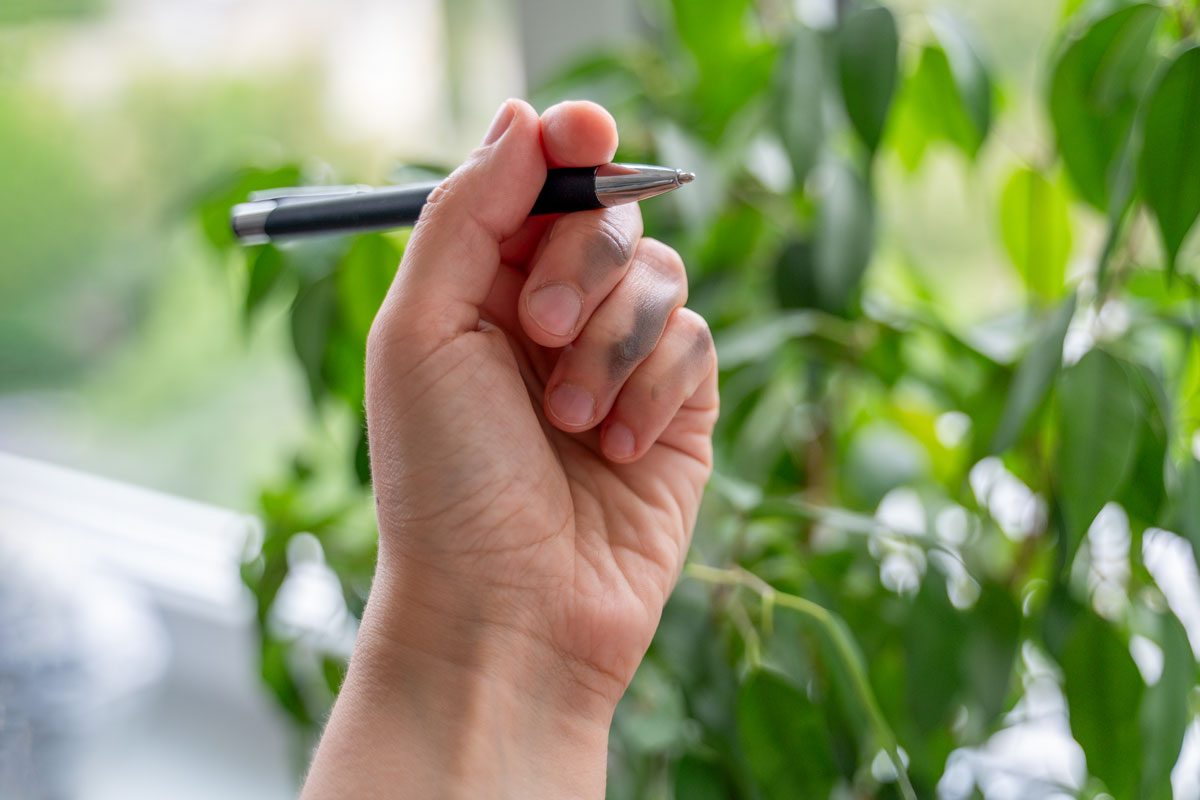Imagine being able to write a letter or catch a baseball with either hand. Here's the fascinating science of ambidextrous people who mix it up like pros.

What Does It Mean to Be Ambidextrous?

Most of us are firmly righty or lefty. We have the go-to hand we favor for just about everything, and we have the hand that’s … less useful. But there is a third type of handedness you might have heard of: being ambidextrous.
If you are like me and can barely hold a pen with your opposite hand, it may be mind-boggling to think that some people can write with perfect penmanship, serve a tennis ball or work a curling iron using their nondominant hand. It makes you wonder: Do ambidextrous people do everything equally well from either side—or only certain tasks? Do they start out left-handed or right-handed and teach themselves to switch it up? Are they more likely to be athletic (see: switch-hitters)?
To get to the bottom of these and other mysteries, we reached out to two cognitive science experts: neuroscientist Alicia Walf, PhD, an assistant professor at Rensselaer Polytechnic Institute in Troy, New York, and Clare Porac, PhD, professor emerita of psychology at Penn State University and author of Laterality: Exploring the Enigma of Left-Handedness. Here is what the pros want us to know about ambidexterity and mixed-handedness.
Get Reader’s Digest’s Read Up newsletter for more interesting facts, humor, travel, tech and entertainment all week long.
What does it mean to be ambidextrous?

If you are ambidextrous, you are equally skilled at using both hands. But there’s some nuance to the ambidextrous meaning—the key word is equally. Ambidextrous people aren’t just able to underhand a ball or grab an apple with their opposite hand. They are fully able to use both hands for fine motor tasks like writing a note or buttoning their shirt.
Never met anyone with that superpower? That’s not surprising—this trait is super rare. What percent of the population is ambidextrous? “Only about 1%,” Walf says.
What’s more common is mixed-handedness. People who are mixed-handed teach themselves to do certain things (but usually not everything) from either side. Porac, who has studied and written about handedness for decades, says that as many as 35% of people are mixed-handed. Lefties are more likely to be mixed-handed than righties. In some cases, that is because they were forced to do things with their right hand as a child by a parent or teacher and ended up getting pretty dang good at it.
Paul McCartney falls into this category: The Beatles icon is a southpaw but has shared that he had to learn to play the bass guitar with his right hand because, in his early days of playing in bars, he would often have to borrow another musician’s guitar—inevitably, a right-handed one.
Are the brains of ambidextrous people different?
As you may remember from biology class, our brains have two asymmetrical hemispheres, with the left and right sides each specializing in certain functions. In most people, the left side of the brain and the right hand are dominant, explains Walf. In lefties, the right side of the brain is dominant—though lefties tend to be a bit more whole-brained than righties are.
But in ambidextrous people, “this lateralization, or asymmetry, does not exist to the same extent,” Walf says. In other words, ambidextrous people are more whole-brained.
Are there any advantages to being ambidextrous?
Ambidextrous people are not naturally gifted athletes—that’s a myth. But many athletes have trained themselves to use either hand. From Yankees Hall of Famer Mickey Mantle to tennis great Maria Sharapova, there is an A-list roster of elite athletes who are mixed-handed. Yet it’s not something any old slugger or point guard can master: “ It’s easier for some people to achieve proficiency on the opposite hand, while others have to practice more,” Porac says.
Being mixed-handed doesn’t only give you an edge on a baseball diamond or tennis court. It also carries a practical benefit, Porac notes: “It can help in the event you have a hand injury.”
You may have heard that ambidextrous people are naturally more creative, but that’s a fallacy. “Our left and right brains are typically connected and working together when we do complex tasks, like creative pursuits,” says Walf. “There is no clear evidence that being ambidextrous causes greater creativity.”
Are there famous ambidextrous people?

Many famous people are mixed-handed, but it’s not clear who’s actually ambidextrous. “Even though some people claim that they can do everything equally well with the right and left hand, it’s often not the case,” Porac notes. One household name of yore believed to be truly ambidextrous is the original Renaissance man, Leonardo da Vinci. “He supposedly could write equally well with both hands, and that is a very difficult task to achieve,” Porac says.
Some music stars are famously mixed-handed. Guitar genius Jimi Hendrix is one, according to the Musicians Hall of Fame in Nashville. The rock legend played guitar lefty, but he did other things with his right hand. Maroon 5 frontman Adam Levine writes and sketches with his right hand but does most everything else lefty.
Other well-known people who were mixed-handed include physicist Albert Einstein, musician Ringo Starr, figure skater Michelle Kwan, NBA star LeBron James and New York Mets shortstop Francisco Lindor.
A few presidents had this special skill too: James Garfield and Ronald Reagan were in the mixed-handed club, according to the History Channel. Garfield was likely a born southpaw who was forced to write with his opposite hand—and just one of many famous left-handed people.
Is mixed-handedness linked to mental health problems?
Being mixed-handed might be associated with mental health challenges. A 2023 study published in Neuroscience & Biobehavioral Reviews found a link between mixed-handedness and post-traumatic stress disorder (PTSD). Since PTSD doesn’t develop early in life but handedness does, the researchers concluded that being mixed-handed might be a risk factor for later developing PTSD.
There also may be an association between mixed-handedness and schizophrenia. In fact, a 2024 study published in European Archives of Psychiatry and Clinical Neuroscience found a higher percentage of mixed-handedness in people with schizophrenia than in healthy controls. But to be clear, being mixed-handed doesn’t put you at risk for schizophrenia. “You’re not schizophrenic because you’re mixed-handed—you’re mixed-handed because you’re schizophrenic,” Porac says.
Can someone become ambidextrous through practice?
Ambidextrousness is a very rare ability, so attaining it through practice is unlikely. But just about anyone can teach themselves to be mixed-handed.
“It may take extensive training, but it is not impossible,” Walf says. “In most cases, people are able to skillfully use both hands for specific tasks, rather than every single fine motor task that we do with our hands.” So if you are right-handed, you might be able to shoot pool from the left side but still struggle to write neatly enough with your left hand that another human can make out your words.
Is it good for your brain to switch hands?
That is the zillion-dollar question: Can using your nondominant hand bolster your brain? You may have heard that you should switch to your opposite hand to do everyday tasks like brushing your teeth because that habit will encourage brain neuroplasticity—our brain’s process of adapting to challenges and forming new neural networks. It sounds good in theory, but there is no evidence to support this habit, Walf says.
When we’re training to use our nondominant hand, “we assume there have been changes in brain plasticity, so we might think this training is good for the brain,” she explains. “But it might actually be advantageous for the brain to be lateralized, sharing the same hemisphere for similar tasks and engaging the other hemisphere for different tasks.”
So the bottom line is you should use whatever side feels comfortable, whether it’s your right or left hand—or both if you’re ambidextrous.
About the experts
|
Why trust us
At Reader’s Digest, we’re committed to producing high-quality content by writers with expertise and experience in their field in consultation with relevant, qualified experts. We rely on reputable primary sources, including government and professional organizations and academic institutions as well as our writers’ personal experiences where appropriate. We verify all facts and data, back them with credible sourcing and revisit them over time to ensure they remain accurate and up to date. For this piece on being ambidextrous, Lisa Lombardi tapped her experience as a longtime health reporter and the author of What the Yuck?! The Freaky and Fabulous Truth About Your Body to ensure that all information is accurate and offers the best possible advice to readers. Read more about our team, our contributors and our editorial policies.
Sources:
- Alicia Walf, PhD, assistant professor of cognitive science at Rensselaer Polytechnic Institute; email interview, Feb. 13, 2025
- Clare Porac, PhD, professor emerita of psychology at Penn State University; phone interview, Feb.13, 2025
- Guitar Player: “‘John Learned Upside Down Too, Because of Me.’ Paul McCartney Said Necessity Made Him and John Lennon Learn to Be Ambidextrous Guitar Players”
- Sci News: “Leonardo da Vinci Was Ambidextrous, Researchers Say”
- Musicians Hall of Fame & Museum: “Why Did Jimi Hendrix Play His Guitar Upside Down”
- History.com: “The First Left‑handed President Was Ambidextrous and Multilingual”
- Neuroscience & Biobehavioral Reviews: “Handedness in post-traumatic stress disorder: A meta-analysis”
- European Archives of Psychiatry and Clinical Neuroscience: “Handedness in Schizophrenia and Affective Disorders: A Large-Scale Cross-Disorder Study”





















